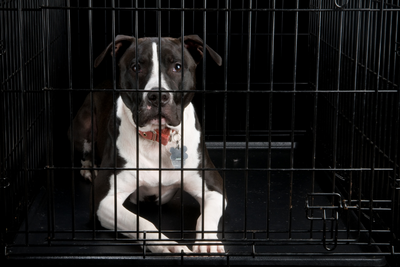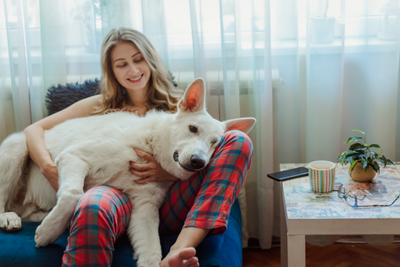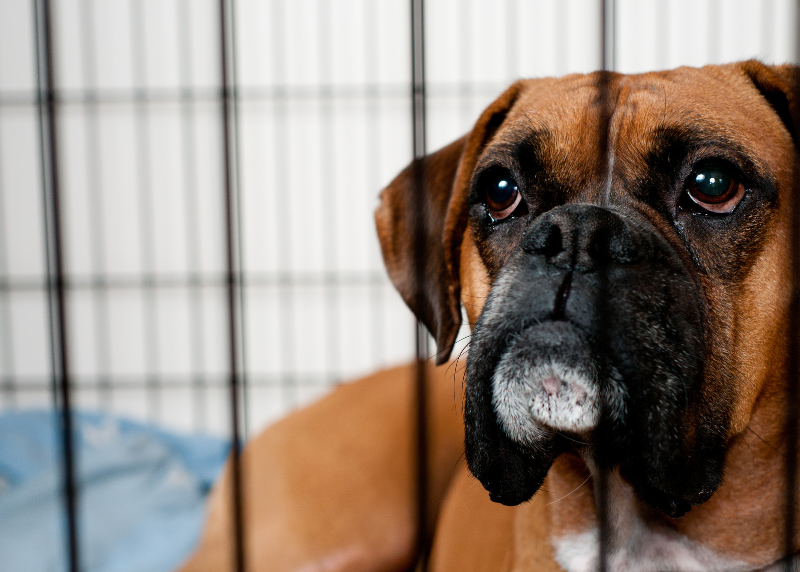Do you have to leave your dog at home all day while you’re at work? If so, is it okay to crate them? This is a question that a lot of city-dwellers face.
Fortunately, we’re here to help!
In this blog post, we will discuss the pros and cons of crating your dog when you’re away from home. We will also provide some tips on how to make the crate experience as comfortable as possible for your furry friend.
What Is A Dog Crate And Why Would You Use One?

A dog crate is a small, enclosed space that can be used to confine your dog. It can be made out of metal, plastic, or wood and it typically has a door that can be opened and closed. Dog crates are often used as training tools, but they can also be useful when you’re away from home.
For example, if you have to leave your dog at home for an extended period of time, you can put them in the crate. This will help keep them safe and out of trouble.
Most puppies that come from a breeder have been crate trained and if you are lucky your new furry friend already loves their crate.
If your dog is hesitant or scared of the crate at first, don’t give up. It may take a little bit of time and educating yourself on successful crate training, but eventually they will come to see it as their safe place.
==>LEARN MORE ABOUT OUR DOG WALKING SERVICES<==
The Pros Of Using A Dog Crate

Let’s start by looking at the positive aspects of using a dog crate.
Staying Out of Trouble: The first benefit is that it allows you to leave your dog alone while you’re away from home without worrying about them getting into trouble or destroying anything in the house.
Puppy Potty Training: A crate can also be helpful for potty training puppies, which is why many dog trainers recommend using them during this period of time. (Make sure you get the right size crate though. If its too big your puppy will still potty in it).
Traveling: If you plan on traveling with your dog it’s a good idea to crate train them beforehand so they know what to expect when they get there. This will help keep them calm and avoid any unwanted accidents. Some hotels might require you to put your dog in a crate if you are leaving them in your hotel room.
High-rise Living: Many buildings require dogs to be in a crate while they come to service your unit. Being able to ask your dog walker to quickly place them the crate prior to maintenance or cleaning service arriving can help everything proceed more smoothly.
Medical Treatment: If your dog is sick or injured, having them in a crate will keep them from moving around too much and making the situation worse. This can also help prevent separation anxiety because it stops them from getting distressed while you’re away at work etc…
You might also be interested in:
- Does My Dog Have A Weight Problem?
- House Breaking Small Breed Dogs: 10 Tips For New Pet Parents
- How to Find the Best Dog Walking Company [for you] in Chicago il
The Cons Of Using A Dog Crate

Now let’s take a look at some of the potential drawbacks of using a dog crate
Boredom: One downside is that crates can be quite boring for dogs, especially if they are left in them for long periods of time. This can lead to them becoming restless and depressed.
Lack of Exercise: Another downside is that crating your dog can lead to them getting less exercise, which can be bad for their health. (that is why it is highly suggested to have a dog walking service come take your pup out during the midday if you are in the office)
Insecurity: Dogs who are crate trained may start to view the crate as their safe place. If you suddenly stop using it, they might feel insecure and need time to adjust.
Barking: If you start using a crate prematurely before they are properly trained and comfortable, your dog could start to act upon his discomfort. if they start barking of whining incessantly, you might receive notice of complaints from your neighbors.
How To Introduce Your Dog To The Crate And Make Them Feel Comfortable In It

Now that you have a general idea of the pros and cons of using a dog crate, let’s go over how to introduce your pup to it. The most important thing is to make sure your dog is comfortable with the crate before you start using it for long periods of time.
The first step is to get your dog used to the sight and smell of the crate. Leave it open in a common area and put some treats inside so they will start associating good things with it. Once they are comfortable going near it, you can start closing the door for very short periods of time (seconds at first, then gradually longer).
If your dog gets distressed by being in the crate, you should stop what you are doing and come back later. The goal is for them to feel secure and relaxed before moving on to another step. You can also try giving them a treat or toy while they’re inside so that it becomes more enjoyable for them when they are left there alone with nothing else to do.
Training is almost never easy and depending on your dog’s temperament they might challenge the crate with all their might. In that case I highly recommend consulting with a dog trainer so that you can get the support you need to help the crate training process.
Is It Ok To Leave Your Dog Crated All Day?

Dogs are social creatures and they thrive off of attention. Leaving them in a crate all day while you work or do errands can lead to boredom, depression, barking/whining and even separation anxiety.
If you need to leave your dog alone for extended periods of time it’s important that he feels like he has something else to do. This might mean providing him with a few toys or treats, hiring a dog walker to come by during the day, or enrolling them in doggy daycare.
Your dog’s breed and age will affect how long they can stay in a crate. According to the Humane Society, puppies under 6 months as well as senior dogs should not be crated for more than 3-4 hours as they will need to go potty by that time. Although dog’s who are house trained can be crated for about half a day, it is recommended to graduate them to a section of the house or larger spaces when possible.
Let Us Help You With Your Dog’s Routine
A dog crate can be a valuable tool for training your dog and helping them feel safe and secure. If you’re thinking about using a crate, make sure to introduce your dog gradually and only leave them crated for short periods of time.
Chicago Urban Pets can help support your dog’s routine that includes regular walks and potty breaks. This way your furry friend stays healthy and happy whether they’re in their crate or out exploring the city streets.


